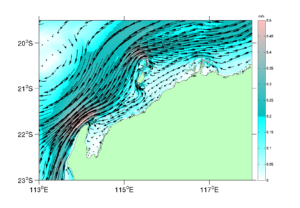Environmental pressures
Understanding factors that can cause environmental change
Project lead: Ryan Lowe (UWA) and Ming Feng (CSIRO)
Environmental pressures are factors that can cause environmental change in the marine environment. Ocean circulation, human influence, and natural climate variability, as well as extreme events such as marine heatwaves and tropical cyclones, are important factors to drive the environmental pressures off the Pilbara coast.
The PMCP environmental pressures project
The PMCP environmental pressures project, jointly led by The University of Western Australia and CSIRO Oceans and Atmosphere, has provided background environmental information to the broad PMCP program, such as regional circulation, marine connectivity, and biodiversity. The project also identified hot spots of biodiversity and connectivity to guide the field works in other PMCP projects.

Longterm model surface velocities for the month of April.
The PMCP environmental pressures project and was divided into three areas of investigation:
The project has mapped marine habitats and their associated biodiversity across the length and breadth of the west Pilbara shelf, developed high-resolution 3-dimensional models of shelf circulation to map out the “connectedness” of coral reefs and fish habitats in the Pilbara region, and used a combination of remote sensing, in-situ field observations and numerical modelling to assess the drivers of environmental variability across the region.
What will the research help to answer?
The research has helped to answer some key management questions such as:
- What are the dominant oceanography processes that are important for the ecosystem health of the North West Shelf?
- What are the climate drivers of ocean circulation on the shelf North West Shelf?
- What drives the connectivity among coral reefs in the region and where are the source and sink hot spots of larval recruitment on the North West Shelf?
- What are the biodiversity levels in sanctuary or special purpose zones and their exposure to human use?
